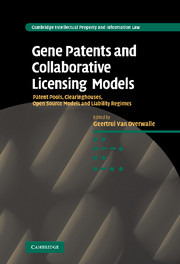 Gene Patents and Collaborative Licensing Models
Gene Patents and Collaborative Licensing Models Book contents
- Frontmatter
- Contents
- List of contributors
- Preface
- Foreword: Jean-Jacques Cassiman
- List of abbreviations
- Part I Patent pools
- Part II Clearinghouses
- Part III Open source models
- Part IV Liability regimes
- Part V Different perspectives
- 20 Gene patents: from discovery to invention. A geneticist's view
- 21 ‘Patent tsunami’ in the field of genetic diagnostics. A patent practitioner's view
- 22 Gene patents and clearing models. Some comments from a competition law perspective
- 23 Access to genetic patents and clearing models. An economic perspective
- 24 The role of law, institutions and governance in facilitating access to the scientific research commons. A philosopher's perspective
- Part VI Summary and concluding analysis
- Index
- Titles in the series
21 - ‘Patent tsunami’ in the field of genetic diagnostics. A patent practitioner's view
from Part V - Different perspectives
Published online by Cambridge University Press: 14 January 2010
- Frontmatter
- Contents
- List of contributors
- Preface
- Foreword: Jean-Jacques Cassiman
- List of abbreviations
- Part I Patent pools
- Part II Clearinghouses
- Part III Open source models
- Part IV Liability regimes
- Part V Different perspectives
- 20 Gene patents: from discovery to invention. A geneticist's view
- 21 ‘Patent tsunami’ in the field of genetic diagnostics. A patent practitioner's view
- 22 Gene patents and clearing models. Some comments from a competition law perspective
- 23 Access to genetic patents and clearing models. An economic perspective
- 24 The role of law, institutions and governance in facilitating access to the scientific research commons. A philosopher's perspective
- Part VI Summary and concluding analysis
- Index
- Titles in the series
Summary
Introduction
Patentability of human genes has always been a problematic issue in terms of ethics, but in fact the real problem is a practical one, especially in the field of genetic diagnostics. The key problem is a problem of ‘freedom to operate’.
Projects including genes or proteins
A recent article in Science provides interesting information on the phenomenon of ‘patent tsunami’ in the field of genetic research. From this analysis it appears for example that Bone Morphogenetic Protein 7, a particular protein, has been the subject of a patent application twenty times. The same is true for genes on protein CDKN2A. Furthermore, the survey demonstrates that 150 genes/proteins have been the subject of more than five patent applications.
So, if one intends to use such a protein or gene in a project, it is necessary to make a ‘freedom to operate analysis’ (FTO). Such a FTO involves identifying all corresponding patents and determining which ones are valid and pertinent for the project, as well as to determine the corresponding strategy, that is, negotiating, ignoring or challenging (depending on the strength of the patents), and negotiating if necessary.
The situation may be more complicated especially in the field of diagnostics. In this field, genes or proteins are used as biomarkers to characterize a certain pathology. Generally there is a need for several genes or proteins for only one diagnostic test.
- Type
- Chapter
- Information
- Gene Patents and Collaborative Licensing ModelsPatent Pools, Clearinghouses, Open Source Models and Liability Regimes, pp. 331 - 338Publisher: Cambridge University PressPrint publication year: 2009


